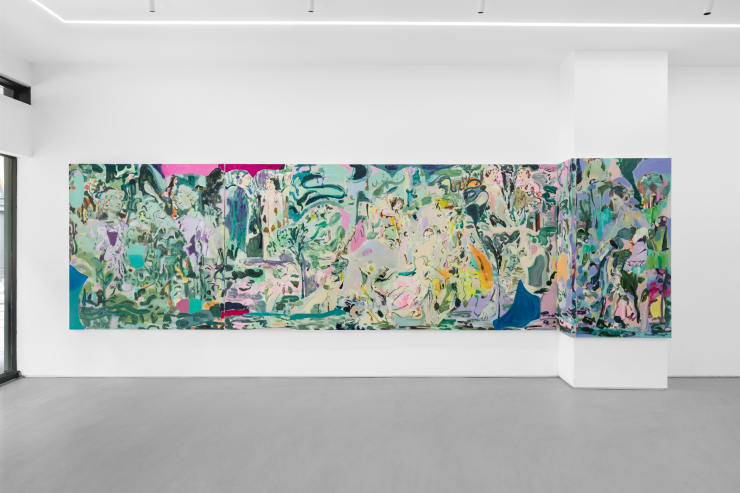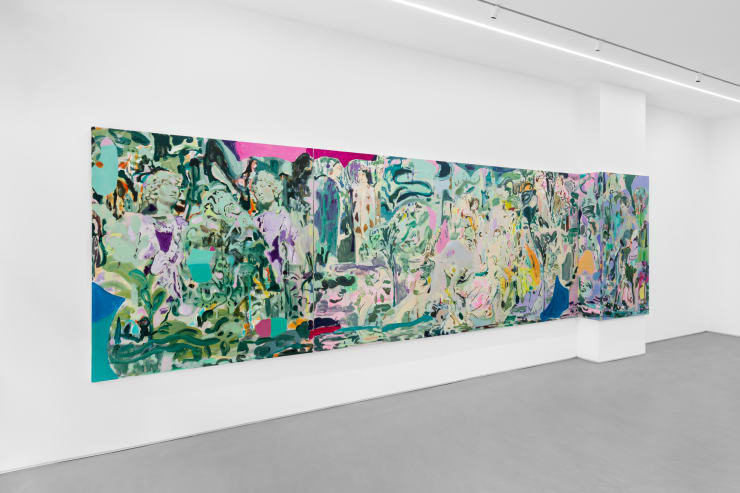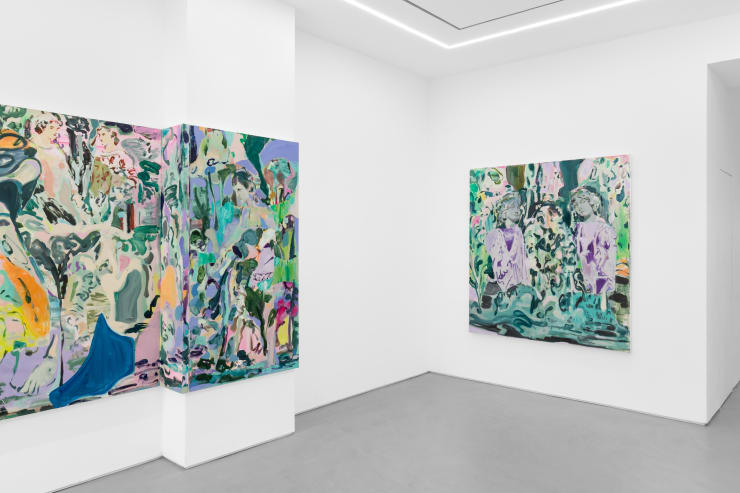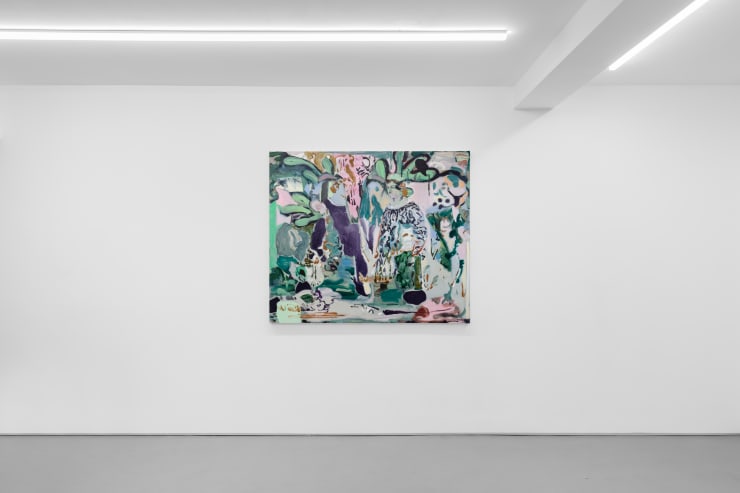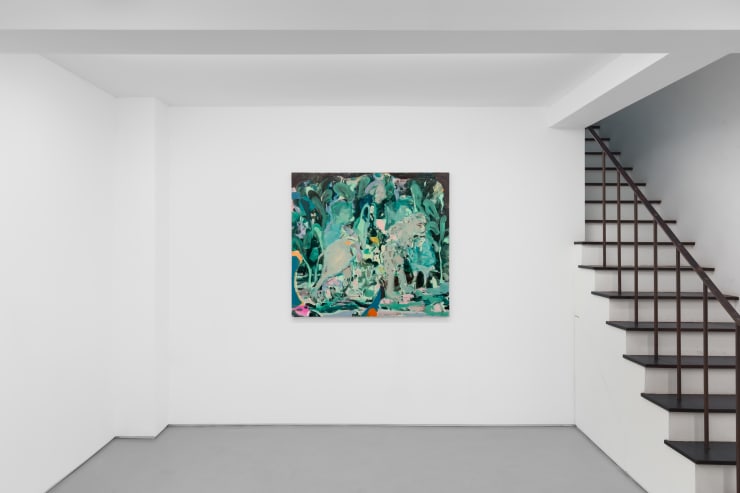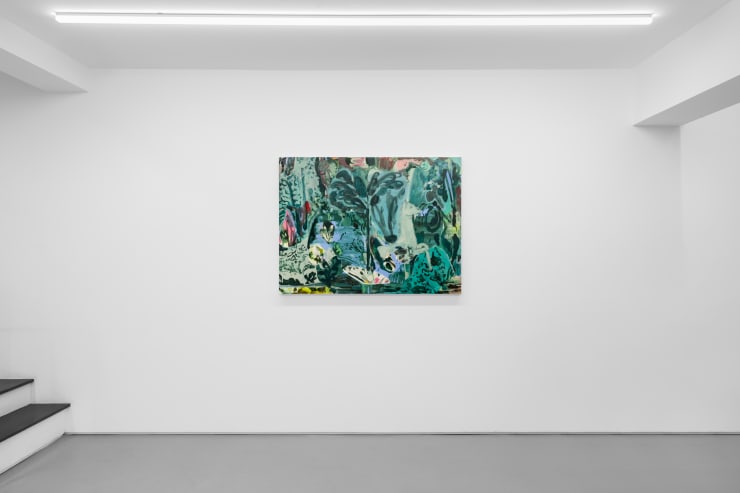Happy Days : Tomo Campbell
Past exhibition
Text
Cob Gallery is pleased to present Happy Days, British artist Tomo Campbell’s fourth solo exhibition at the gallery, comprising a suite of eight oil paintings on canvas.
Happy Days takes its title from Samuel Beckett’s 1961 play, in which a woman is gradually buried in the earth while continuing her daily rituals. The phrase “happy days” becomes her refrain, both cheerful and fatal, an optimism uttered in the face of inevitability.
Campbell’s figures persist in a similar condition: provisional presences, half-submerged in dragged colour and pattern, surviving amid the instability that threatens to erase them. Their gestures, washing, lifting, pouring, are fragile repetitions, looping without resolution.
The title also echoes everyday speech. In English, “happy days” is a throwaway idiom used for celebration, resignation, or irony. Campbell embraces this ambiguity. His paintings occupy the same register: intricate yet unstable, layered yet always on the verge of collapse.
The exhibition continues Campbell’s exploration of the frieze format, building on his presentation at The Armory Show, New York (2024). The arrangement forms a continuous sequence in which motifs and visual elements flow seamlessly from one work to the next. From the gallery’s entrance, the sightline suggests an unbroken continuum, wrapping around the architectural features of the space.
Campbell’s paintings are built through accumulation and return. Motifs are borrowed, revised, and folded back into new compositions so that each work carries the ghost of another within it. Figures, animals, and ornamental fragments drift between canvases as if borne by a current. The artist paints not from direct observation but from recollection; his images emerge from the memory of painting itself.
He likens his process to tapestry, both in physical presentation and conceptual layering. Like woven textiles, the works stitch together diverse motifs and imagery, hot and cold, fast and slow, old and new, into intricate, layered compositions. When individual canvases are displayed apart from the main frieze, this continuity fractures, producing a sense of glitch or disruption, as if the patchwork momentarily threatens to unravel. This interplay of cohesion and tension reinforces the dualities at the heart of Campbell’s practice, keeping the viewer suspended between expectation and surprise.
Colour functions as both pulse and interruption. Where earlier works drew on the restraint of fresco and historical palette, here it mutates into something synthetic: sharp magentas, theatrical greens, near-digital blues. These jolts prevent the viewer from drifting into nostalgia, insisting that the act of looking and of painting remains defiantly contemporary.
History enters not as citation but as atmosphere. Mughal hunts, medieval unicorns, and classical fragments persist only as traces, pliable matter to be cut, repeated, or dissolved. In Campbell’s hands, hierarchy collapses: figures and foliage, relic and residue share equal weight. Each canvas becomes less a window than a surface that holds itself together through its own disarray, a patchwork of vivid, precarious gestures.
Through this method, Campbell explores how images from history endure, not as stable icons, but as unstable repetitions, half-remembered and reassembled with each return. In Happy Days, fragility itself becomes a form of continuity. The paintings move between elegy and rehearsal, ruin and renewal. Figures appear to pour paint back into the flood, sustaining the very instability that threatens to engulf them. They inhabit Beckett’s doubled tone, where persistence becomes a kind of faith, and endurance, however provisional, the last form of happiness left.
Works
-
 Tomo CampbellWell, 2025Oil on canvas160 x 150 cm
Tomo CampbellWell, 2025Oil on canvas160 x 150 cm
63 x 59 in -
 Tomo CampbellThat's What I Always Say, 2025Oil on canvas160 x 320 cm
Tomo CampbellThat's What I Always Say, 2025Oil on canvas160 x 320 cm
63 x 126 in -
 Tomo CampbellAnd Then, 2025Oil on canvas160 x 83 cm
Tomo CampbellAnd Then, 2025Oil on canvas160 x 83 cm
63 x 32 5/8 in -
 Tomo CampbellSignal, 2025Oil on canvas160 x 150 cm
Tomo CampbellSignal, 2025Oil on canvas160 x 150 cm
63 x 59 in -
 Tomo CampbellKeep, 2025Oil on canvas173 x 273 cm
Tomo CampbellKeep, 2025Oil on canvas173 x 273 cm
68 1/8 x 107 1/2 in -
 Tomo CampbellElsewhere , 2025Oil on canvas110 x 120 cm
Tomo CampbellElsewhere , 2025Oil on canvas110 x 120 cm
43 1/4 x 47 1/4 in -
 Tomo CampbellJust Maybe, 2025Oil on canvas120 x 140 cm
Tomo CampbellJust Maybe, 2025Oil on canvas120 x 140 cm
47 1/4 x 55 1/8 in -
 Tomo CampbellMy My , 2025Oil on canvas90 x 120 cm
Tomo CampbellMy My , 2025Oil on canvas90 x 120 cm
35 3/8 x 47 1/4 in
Installation Views









